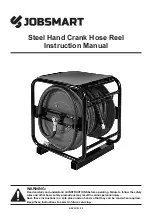
6
Power tool use and care
Do not force the power tool. Use the correct
power tool for your application.
The correct
power tool will do the job better and safer at the
rate for which it was designed.
Do not use the power tool if the switch does
not turn it on and off.
Any power tool that
cannot be controlled with the switch is
dangerous and must be repaired.
Disconnect the plug from the power source
and/or the battery pack from the power tool
before making any adjustments, changing
accessories, or storing power tools.
Such
preventive safety measures reduce the risk of
starting the power tool accidentally.
Store idle power tools out of the reach of
children and do not allow persons unfamiliar
with the power tool or these instructions to
operate the power tool.
Power tools are
dangerous in the hands of untrained users.
Maintain power tools. Check for
misalignment or binding of moving parts,
breakage of parts and any other condition
that may affect the power tool’s operation. If
damaged, have the power tool repaired
before use.
Many accidents are caused by
poorly maintained power tools.
Keep cutting tools sharp and clean.
Properly
maintained cutting tools with sharp cutting
edges are less likely to bind and are easier to
control.
Use the power tool, accessories and tool bits
etc. in accordance with these instructions,
taking into account the working conditions
and the work to be performed.
Use of the
power tool for operations different from those
intended could result in a hazardous situation.
Service
Have your power tool serviced by a qualified
repair person using only identical
replacement parts.
This will ensure that the
safety of the power tool is maintained.
WARNING:
This product contains
chemicals known to the State of California to
cause cancer and birth defects or other
reproductive harm.
WARNING
: Some dust created by power
sanding, sawing, grinding, drilling, and other
construction activities contain chemicals
known to cause cancer, birth defects, or
other reproductive harm.
Some samples of
these chemicals are:
lead from lead-based paints,
crystalline silica from bricks and
cement and other masonry products,
and
arsenic and chromium from
chemically-treated lumber.
Your risk from these exposures varies,
depending on how often you do this type of
work. To reduce your exposure to these
chemicals: work in a well-ventilated area, and
work with approved safety equipment, such as
those dust masks that are specially designed to
filter out microscopic particles.
Always wear eye protection. Any power tool can
throw foreign objects into your eyes and cause
permanent eye damage. ALWAYS wear safety
goggles (not glasses) that comply with ANSI
safety standard Z87.1. Everyday glasses have
only impact resistant lenses. They ARE NOT
safety glasses.
WARNING:
Glasses or goggles not in
compliance with ANSI Z87.1 could cause
serious injury when they break.
Never allow fingers or clothing to contact the
buffing/polishing pads while tool is
operating.
Always use two hands to control the
buffer/polisher
to avoid loss of control.
Never submerge the buffer/polisher in water
or any other liquid.
The tool will be damaged
and fire could result.
SAVE THESE INSTRUCTIONS FOR REFERENCE
POWER TOOL SAFETY
SPECIFIC SAFETY RULES
!
!
!
Содержание 172042
Страница 16: ...16 EXPLODED VIEW...



































